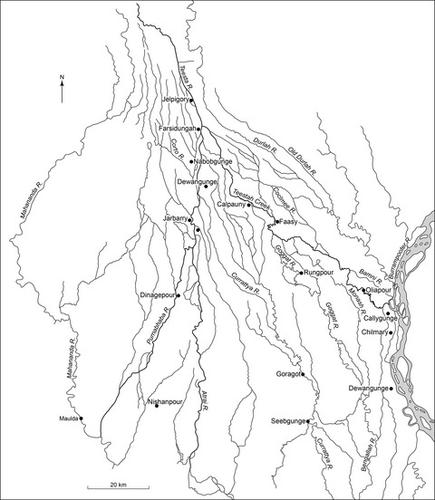Our official English website, www.x-mol.net, welcomes your feedback! (Note: you will need to create a separate account there.)
The historical avulsion of the Tista River, and its relationship to the Brahmaputra: Map and archive evidence from 1750 to 1835
The Geographical Journal ( IF 3.384 ) Pub Date : 2021-04-12 , DOI: 10.1111/geoj.12391 Keith Richards 1 , Hugh Brammer , Patricia Saunders 2
The Geographical Journal ( IF 3.384 ) Pub Date : 2021-04-12 , DOI: 10.1111/geoj.12391 Keith Richards 1 , Hugh Brammer , Patricia Saunders 2
Affiliation

|
Alluvial fans are constructed when river deposition raises local elevations until the river “avulses” to an alternative lower elevation alignment. Avulsions may be triggered by exogenous events, such as floods that locally overtop the river’s banks; they may then cause extreme flooding on a fan and have major impacts. Rivers draining the Himalayas into the Gangetic plain have behaved historically in this way; for example, the Kosi River’s historical westward migration (1731–1963), and its recent eastward shift (1980). In the major fan-delta of the Bengal Basin, the Brahmaputra and its tributary, the Tista, have both undergone historical avulsions, with some suggestion that these may have been causally linked. Between the Rennell survey of Bengal (1765–77) and the partial re-survey by Wilcox and Ommanney (1828–35), the Brahmaputra River substantially changed its course. In Rennell’s time it turned south-east into the Sylhet Basin leaving the higher land of the Madhupur Tract on its right; by 1830, it flowed due south with the Tract on its left. One hypothesis for the timing and cause of this avulsion relates it to the impact of a major flood and avulsion in the River Tista in 1787. This paper examines the evidence of the Rennell maps, the East India Company archives of correspondence between District Collectors about flooding and avulsion in the Tista, and the diaries of Francis Hamilton Buchanan who travelled along the Tista in 1807–11. From these contemporary sources it is possible to re-construct the changes in the River Tista in the late 18th century, and to conclude that its avulsion had little direct influence on that of the Brahmaputra, although it went through some radical rearrangements of its own.
中文翻译:

蒂斯塔河的历史侵蚀及其与雅鲁藏布江的关系:1750 年至 1835 年的地图和档案证据
当河流沉积使当地海拔升高,直到河流“冲断”到另一条低海拔路线时,就会建造冲积扇。外源性事件可能会引发撕脱,例如局部泛滥河岸的洪水;然后它们可能会对风扇造成严重的洪水并产生重大影响。将喜马拉雅山排入恒河平原的河流在历史上就是这样的。例如,科西河历史上的西移(1731-1963),以及最近的东移(1980)。在孟加拉盆地的主要扇三角洲,雅鲁藏布江及其支流蒂斯塔河都经历了历史性的侵蚀,有人认为这可能存在因果关系。在孟加拉的 Rennell 调查(1765-77)和 Wilcox 和 Ommanney(1828-35)的部分重新调查之间,雅鲁藏布江大幅改变了航向。在伦内尔时代,它转向东南进入锡尔赫特盆地,在其右侧留下较高的马杜普尔地区;到 1830 年,它流向正南,左边是道。关于这次大洪水的时间和原因的一个假设将其与 1787 年蒂斯塔河的大洪水和大洪水的影响联系起来。 本文检查了伦内尔地图的证据,东印度公司地区收藏家之间关于洪水的通信档案和蒂斯塔的撕脱,以及弗朗西斯·汉密尔顿·布坎南 (Francis Hamilton Buchanan) 的日记,他于 1807-11 年沿着蒂斯塔 (Tista) 旅行。从这些当代资料中,可以重新构建 18 世纪后期蒂斯塔河的变化,并得出结论,它的撕裂对雅鲁藏布江几乎没有直接影响,
更新日期:2021-04-12
中文翻译:

蒂斯塔河的历史侵蚀及其与雅鲁藏布江的关系:1750 年至 1835 年的地图和档案证据
当河流沉积使当地海拔升高,直到河流“冲断”到另一条低海拔路线时,就会建造冲积扇。外源性事件可能会引发撕脱,例如局部泛滥河岸的洪水;然后它们可能会对风扇造成严重的洪水并产生重大影响。将喜马拉雅山排入恒河平原的河流在历史上就是这样的。例如,科西河历史上的西移(1731-1963),以及最近的东移(1980)。在孟加拉盆地的主要扇三角洲,雅鲁藏布江及其支流蒂斯塔河都经历了历史性的侵蚀,有人认为这可能存在因果关系。在孟加拉的 Rennell 调查(1765-77)和 Wilcox 和 Ommanney(1828-35)的部分重新调查之间,雅鲁藏布江大幅改变了航向。在伦内尔时代,它转向东南进入锡尔赫特盆地,在其右侧留下较高的马杜普尔地区;到 1830 年,它流向正南,左边是道。关于这次大洪水的时间和原因的一个假设将其与 1787 年蒂斯塔河的大洪水和大洪水的影响联系起来。 本文检查了伦内尔地图的证据,东印度公司地区收藏家之间关于洪水的通信档案和蒂斯塔的撕脱,以及弗朗西斯·汉密尔顿·布坎南 (Francis Hamilton Buchanan) 的日记,他于 1807-11 年沿着蒂斯塔 (Tista) 旅行。从这些当代资料中,可以重新构建 18 世纪后期蒂斯塔河的变化,并得出结论,它的撕裂对雅鲁藏布江几乎没有直接影响,



























 京公网安备 11010802027423号
京公网安备 11010802027423号